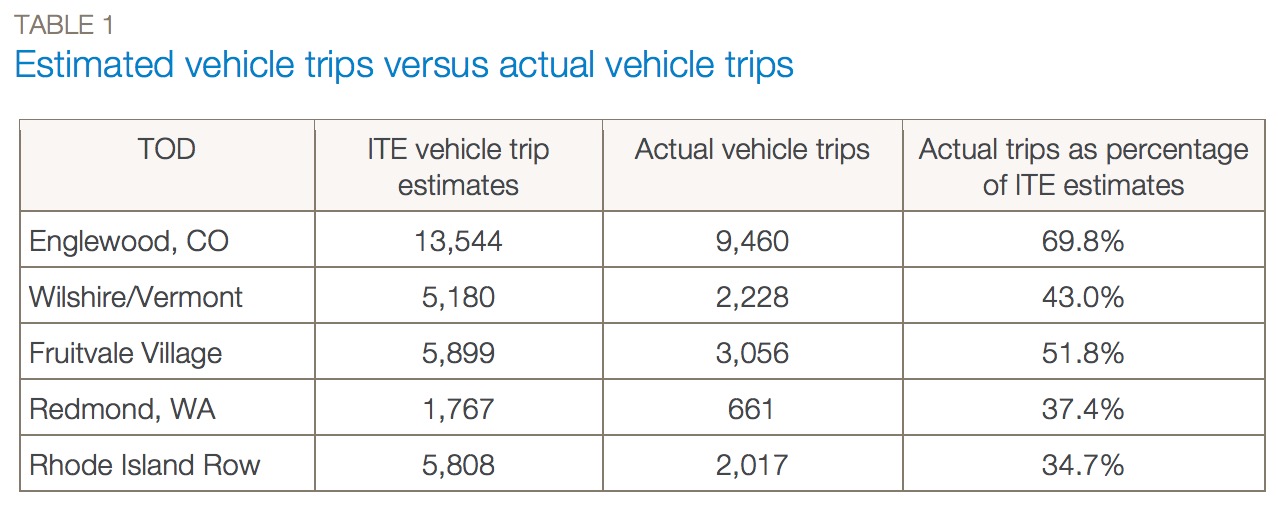SMART GROWTH AMERICA
Executive summary
The land near transit stations is a valuable commodity. Hundreds or thousands of people travel to and through these places each day, and decisions about what to do with this land have implications for local economies, transit ridership, residents’ access to opportunity, and overall quality of life for everyone in a community.
Many communities choose to dedicate at least some of that land for parking. The question is, how much? Too little parking could discourage people from coming to the station, but too much parking is unnecessarily expensive and gets in the way of other uses like homes, shops, or offices. How much parking should transportation engineers build?
To answer that question, many engineers and planners consult the Institute of Transportation Engineers’ (ITE) Trip Generation and Parking Generation guides. These publications represent data collected from mostly isolated suburban land uses—not walkable, urban places served by transit. There are few alternative guidelines for engineers building this other type of development, however, so despite these shortcomings many planners continue to use ITE’s publications.
The goal of this study was to determine how much less parking is required at transit-oriented developments (TODs) and how many fewer vehicle trips are generated than standard industry estimates. It is clear that TODs require less parking than development without transit, or transit without development. This study sought to gather information about how much parking is used at TOD to help developers and engineers make more-informed decisions in the future.
To do that, Professor Reid Ewing and his research team at the University of Utah College of Architecture + Planning selected five TODs across the country, each with a slightly different approach to development and parking: Englewood, CO in the Denver region; Wilshire/Vermont station in Los Angeles, CA; Fruitvale Transit Village in Oakland, CA; the Redmond, WA station in the Seattle region; and Rhode Island Row in Washington, DC. The research team together with two transportation consulting firms, Fehr & Peers Associates and Nelson\Nygaard Consulting Associates, counted all persons entering and exiting the TOD buildings, and conducted brief intercept surveys of a sample of them. Researchers also conducted parking inventory and occupancy counts.
Consistent with other research, this study found that the five TODs generated fewer vehicle trips than ITE publications estimate, and used less parking than many regulations require for similar land uses. And in one case, actual vehicle trips were just one third of what ITE guidelines estimate.
The TODs included in this study also built less parking than recommended by ITE. Yet even this reduced amount of parking was not used to capacity: the ratio of demand to actual supply was between 58 and 84 percent. Fewer vehicle trips is one likely reason why parking occupancy rates were lower than expected. Another possible reason is that ITE’s data do not fully account for other travel modes that are available and actively encouraged at TODs. In each of the five TODs studied, at least 33 percent of trips were taken by modes other than driving. Additional reasons for low parking rates is that parking is shared between commercial and residential uses at two TODs, is shared between transit and park-and-ride uses at one TOD, is unbundled with apartment rents at two TODs, and is priced at market rates for commercial users at three TODs.
These findings underscore the obvious need for developers, regulators, and practitioners to rethink how they use parking guidelines intended for suburban development not served by transit. Current engineering standards are not designed to accommodate this type of development but in time we hope studies like this can help change that. Better aligning industry standards with current needs can reduce the cost of development near transit, and make it easier to build more homes, shops, and offices in these high-demand locations. More detailed results are available in the full academic version of this study and two peer-reviewed articles, all referenced in the Acknowledgments on page 10.
Download full version (PDF): Real Parking Needs at Five TODs
About Smart Growth America
smartgrowthamerica.org
Smart Growth America advocates for people who want to live and work in great neighborhoods. We believe smart growth solutions support thriving businesses and jobs, provide more options for how people get around and make it more affordable to live near work and the grocery store. Our coalition works with communities to fight sprawl and save money. We are making America’s neighborhoods great together.
Tags: Institute of Transportation Engineers, ITE, Parking, SGA, Smart Growth America, TOD, TODs, Transit-Oriented Development







 RSS Feed
RSS Feed